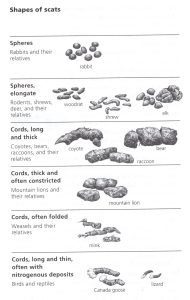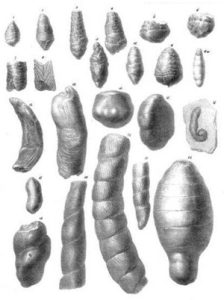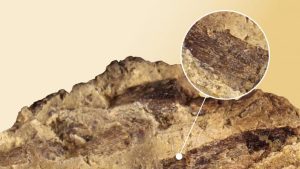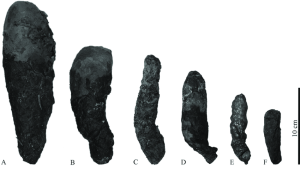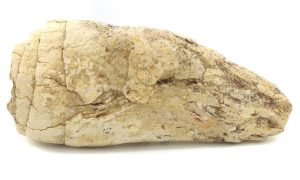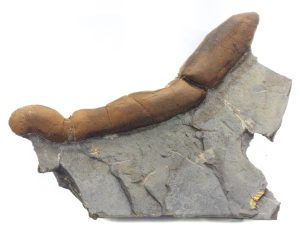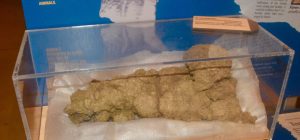Coprolite is fossilized animal poop (feces). The name is derived from the Greek words kopros meaning “dung” and lithos meaning “stone.” Coprolites are called trace fossils (similar to footprints) and are not component body parts of the animals from which they originated. Aspects of the morphology of the source animals cannot be found in coprolites in the manner in which they are found in the study of body fossils like skulls, bones, teeth, and claws. In a few cases evidence of animal behavior such as diet has been hinted at by the study of coprolites. Generally speaking, coprolites are not found close by to associated animal body fossils.
Coprolite can be directly associated with fish fossils such as those found in the Green River formation in Wyoming. There, millions of fossil fish have been found with lots of associated fish coprolites. This supports the idea that the fish and the coprolites were rapidly buried because experiments have shown that the coprolite does not last over 24 hours in solution. Click here for more on the fossils of the Green River formation including fish coprolites.
In practice the primary method for identification of coprolites to their kind of animal source is the shape and size of the coprolite. For example, mammals, reptiles, and birds of today drop feces commonly called scat that can be compared to coprolites. The word “scat” is derived from the Greek word skatos meaning “dung” which is animal excrement. So, the scat shapes seen in Figure 1 can help in guessing the source kind of coprolites but with lots of assumptions. The main assumption used along with the shape of the coprolite is that if animal skeletal fossils have been found in a geologic area, then coprolites found in the same area are often assumed to have come from them. Of course, this is a very tenuous assumption especially if the biblical creationist presupposition of an historic catastrophic global Flood is in play.
Figure 1. Shapes of Scats.
Dinosaurs are among those life forms assumed to be extinct that we have no samples of scat available for comparison. Later in this article I will discuss the coprolite from these animals in more detail.
COPROLITE HISTORY:
The young English fossil enthusiast Mary Anning (1799-1847) from the village of Lyme Regis is credited with first identifying coprolites as fossil feces. Coprolites prior to 1828 were called “fossil fir cones” and “bezoar stones.” Mary worked in conjunction with contemporary geologist William Buckland to develop an understanding of the fossilized poop from sea creatures found in the Lyme Regis rocks such as the ichthyosaurs. Buckland coined the name “coprolite,” and Figure 2 is from Buckland’s 1835 paper on the discovery of coprolites in the Transactions of the Geological Society of London.
Figure 2. Buckland’s Lyme Regis Coprolites.
Buckland had analyses completed on some of the coprolites from Lyme Regis with the findings that they “consisted essentially of calcium phosphate and carbonate and not infrequently contained fragments of unaltered bone.” [1911 Encyclopedia Britannica, Volume 7—Coprolites.]
COPROLITE I.D. SCIENCE:
Much effort has been and is being done in the attempt to identify coprolites. The methods used fall into the categories of shape and size, surface texture, inclusions, and chemistry. As mentioned previously the first method applied is always shape and size. However, not all rocks dug from sedimentary layers that have shapes that are associated with excrement are actually fossilized poop, and many collectors have been sold fake coprolite fossils over the years. The same can be said for surface texture as an identifier.
If a suspected coprolite has inclusions that can be identified as components of an animal’s diet, then that can be very convincing evidence that the item is really coprolite and is also scientifically helpful to infer what the animal ate. Fragments of undigested food, ranging from bones and shells to teeth and plant material, have been found in some coprolites and that pretty much ensures that they are valid samples. This sort of evidence is what Mary Anning found that convinced her that there was such a thing as petrified poop. Figure 3 is a photo of what is thought to be a T-rex coprolite with bone fragments inside.
Figure 3. Bone Fragments in Possible Dinosaur Coprolite from Canada.
If the coprolite diagnosis is correct, then it would be a valid assumption that the contents of the coprolite might provide suggestions as to not only the diet but also the digestive structure of the animal. In order not to destroy valuable samples of coprolite, diagnostic methods such as microscopy, CT scans, and even propagation phase-contrast synchrotron microtomography (PPSM) have been used to look at and inside the coprolites. In Figure 4 is a PPSM image with what are thought to be the remains of three beetle species along with crushed clam shells and parts of fish found in two probable lungfish coprolites. [From Smithsonian Magazine, June 9, 2017.]
Figure 4. Images of Organic Remains found by PPSM Inside Coprolites.
The location of the finding and the chemistry of the coprolite prospective sample are sometimes used to demonstrate that a specimen is authentic. I would say that these methods are very unconvincing in most cases since all coprolites were made as the result of the global Flood some 4,500 years ago. There would have been tremendous mixing of fossils within the varieties of sediments that resulted. In any case it is safe to say that it is nearly impossible to know the producer of any particular sample of coprolite with 100% certainty.
DINOSAUR COPROLITE:
Probably the most popular topic of discussion regarding coprolite are those samples thought to be of dinosaur origin. A high proportion of coprolite sold to the general public is advertised as dinosaur coprolite which it most definitely is not. In my experience any coprolite thought to have been found in what are called Mesozoic sediments and where dinosaur remains have also been found is said to have originated from a dinosaur.
There is some good evidence that dinosaurs had cloacas like crocodilians have. That might indicate that the feces from a dinosaur would physically resemble that from a crocodile. In Figure 5 there are some images of scat from crocodiles.
Figure 5. Fresh Feces from Five Different Species of Crocodile. (10cm = 3.93″.)
Next in Figures 6 and 7 are presented images of coprolites from the Mesozoic that have a somewhat similar shape to that of the crocodiles as seen in Figure 5. Assuming that the shape of the cloacas of dinosaurs and crocodiles are such as to form similar shapes of feces, could either of these two samples be from dinosaurs?
Figure 6. Mesozoic Coprolite from Kansas. Size = 3 1/4″ X 1 1/2″.
Figure 7. Mesozoic Coprolite from England. Size = 4 3/4″ X 3/4″.
So, can you tell if these are dinosaur coprolites? No, you cannot and neither can anyone else. It is not even possible to know if they are from crocodiles. This exercise is intended to exhibit the difficulty in identifying the source of any coprolite.
COPROLITE SHOWMEN:
Natural history museums cannot be faulted for wanting to highlight unusual displays or specimens they own that might increase the traffic to their museums. In 1995 a group of paleontologists from the Royal Saskatchewan Museum were collecting dinosaur bones in the Frenchman geological formation of the Canadian province when they found what they determined to be a large sample of dinosaur coprolite. Inside the specimen were hundreds of bone fragments that indicated that the originator of the coprolite might have been a carnivorous dinosaur. Since T-rex dinosaur bones had been found in the same area it was not long before the coprolite sample was heralded by the museum as “the world’s only known coprolite from a Tyrannosaurus rex!” The sample weighed in at 7 kilograms or about 15 pounds and measured 44 centimeters (17 inches) long. The hoopla for the “dino-sized poop” was worldwide. Figure 8 shows the display at the museum.
Figure 8. Saskatchewan Museum Coprolite Display.
In June 2013 more attention was brought to the specimen when the Saskatchewan museum donated a replica of what they call T-rex coprolite to the Smithsonian Museum of Natural History in Washington, D.C. In the fine print it is clear that no one could be sure it was from a T-rex, nor could they really know that the bone fragments were “likely from a juvenile duck-billed dinosaur, or a horned dinosaur such as Triceratops.” But who really cares since the poop was/is very cool.
In the meantime, in the USA, a coprolite collector by the name of George Frandsen was developing a reputation as a world expert on coprolite. By August 2015 he was listed as the Guiness World Record holder with 1,277 coprolites in his collection and had a website called www.poozeum.com. The record was authenticated by the South Florida Museum in Bradenton, Florida. Figure 9 is the header image from the Guiness website that displays showman Frandsen holding a couple of his best samples.
Figure 9. Geroge Frandsen on the Guiness World Records Website.
By the year 2020 Frandsen had published a book with the title Coprolites of the World and had come into possession of a possible T-rex coprolite from South Dakota that Guiness has certified to be the largest coprolite by a carnivorous animal. This coprolite was larger than the one found in Saskatchewan (weighing over 20 pounds) and Frandsen named it “Barnum” after Barnum Brown the man who discovered T-rex in 1902. The evidence for the coprolite’s description to be from a carnivore consists of bone fragments within the fossil specimen. Even Frandsen acknowledges the connection of the fossil name and his business to the most famous showman of all time, P.T. Barnum. In 2024 Frandsen opened up his Poozeum mini museum in Williams, Arizona (on the way to the Grand Canyon). According to the Guiness website article about Barnum, Frandsen now may have more than 7000 coprolites in his collection. Figure 10 is an image of Frandsen’s book with coprolite Barnum on the cover.
Figure 10. Barnum on the Book Cover in its Protective Plaster Cast.
COPROLITE CONCUSIONS:
One amusing thing I have noticed about coprolites is that almost every person I have witnessed handling a piece of permineralized coprolite always wipes their hands on their pantlegs after putting it down. This is something hardly ever done with other fossils. Of course, this behavior is not necessary but is understandable.
In conclusion, the main thing to remember with coprolites is that it is nearly impossible to know with certainty the source of any sample found, and any suggested animal sources are always subject to justifiable skepticism by one expert or another.
J.D. Mitchell
References:
Currie, P.J. & Padian, K., Encyclopedia of Dinosaurs, “Coprolites,” Academic Press, 1997, pp. 147-150.
Frandsen, George, Coprolites of the World, George Frandsen, 2020.
Halfpenny, James C., Scats and Tracks of the Rocky Mountains—second edition, Globe Pequot Press, 2001.
Mitchell, J.D., Fossils: Description & Interpretation Within a Biblical Worldview, CEC Publications, 2017, pp. 224-225.
Wooley, Daniel A., Journal of Creation, “Fish Preservation, Fish Coprolites and the Green River Formation,” 15(1):105-111, April 2001.
